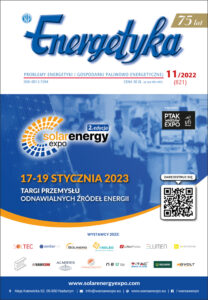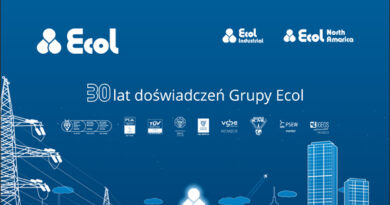November 2022, Issue 11 (821)
TABLE OF CONTENTS
BULLETIN OF ELECTROPROSUMERISM MARKETS
Jan Popczyk
ENERGY TRANSITION OR NUCLEAR POWER INDUSTRY?
entropy and socio-political condition of Poland 2022
Krzysztof Bodzek
ELECTROPROSUMERIC RESILIENCE VS ENERGY SECURITY – models to cover the demand
Marcin Fice
NETWORK ACCESS TERMINAL – functional and technological structure
Marek Szrot, Zdzisław Konopka, Zygfryd Kosidowski, Dariusz Paluszczak
ENERGY TRANSITION IN THE BREAKTHROUGH INNOVATION MODE TO ELECTROPROSUMERISM (TETIPE)
– Energo-Complex case study
POWER ENGINEERING AND OIL MANAGEMENT
Narcyz Bandosz, Przemysław Gawliczek, Jacek Koszyński, Paweł Warczyński
Impact of oil regeneration on the dielectric indices of transformer insulation
POWER ENGINEERING – SCIENCE – INDUSTRY
Mariusz Czechowicz
Jubilee 30th Łukasiewicz-KOMEL Scientific and Technical Conference “Problems of the Operation of Electric Machines and Drives”
OVERTIME LECTURE…
Bogumił Dudek
Our Nobel laureates
SUMMARIES
Jan Popczyk
ENERGY TRANSITION OR NUCLEAR POWER INDUSTRY?
entropy and socio-political condition of Poland 2022
The exponential rise in investments into nuclear energy – in the form of six nuclear units of 1000-1600 MW class (costing not less than 350 billion “pre-inflation” PLN [15] and this only excluding power networks – with them it is more than 400 billion PLN) – requires sounding the alarm. Amongst the others, a renewed synthesis of the energy transition realization triplet [7] is needed as well as a recollection in a new light of key fundamentals of energy transition in the breakthrough innovation mode to electroprosumerism (TETIPE) [1]. And especially it is needed to confront the concept/doctrine and heuristics as well as bottom-up activities (in favour of this transformation) with reports [9] and [10]. Further on, it is necessary to formulate the most important test questions concerning feasibility and rationality of the investment program announced by the Polish government in the last few days of October 2022. Finally, we need an expanded perspective of looking at the Electricity Act, a perspective that leads to the Energy Transition Code [8]. This renewed synthesis of the TETIP transformation realization triplet and recollection of its key fundamentals in a new light is the subject of this article.
Keywords: energy transition, nuclear power industry, energy transition code
Krzysztof Bodzek
ELECTROPROSUMERIC RESILIENCE VS ENERGY SECURITY – models to cover the demand
Development of IC technologies makes it possible to model the present extensive power systems with an overarching criterion in the form of energy security. In such configuration, for the process of this modelling the inductive approach is used i.e. projections including current trends and historical and statistical data, often basing on regression models. This allows modelling of a system development through incremental innovations. Breakthrough innovations, characteristic for electroprosumerism, influence the changes of the present energy market functioning foundations and it needs algorithms taking into account behavioural patterns and heuristic modelling. In many cases probabilistic models are applied. It is necessary to move to solid facts and principles resulting in electroprosumerism from the paradigmatic triplet. Such attitude to the development is characteristic for deductive models which allow to verify transformation realized in the breakthrough innovation mode to electroprosumerism (TETIPE). Described is here the general modelling algorithm, data availability and the idea of building the electroprosumeric resilience. Attached is a table showing interdependencies between competences and functionalities of the system(WSE). Suggested is modelling of supply adequacy in electroprosumerism in exchange for the current energy security.
Keywords: energy transition, energy security, supply adequacy, system modelling
Marcin Fice
NETWORK ACCESS TERMINAL – functional and technological structure
Network Access Terminal (STD) is a set of heavy-current devices (electromechanical elements, connectors, power electronics systems) and the low-current ones (IT infrastructure, programmable controllers) that are located at the contact point of an electroprosumer control front-end (OK) and the distribution system operator (OSD). In particular, the STD terminals are of great importance as they enable electroprosumers the access to LV and MV networks. Some of functionalities and components of STD terminal are already a standard equipment of electroprosumeric electric energy sources. It results from requirements comprised in the Instruction of the Distribution System Operation and Maintenance (IRiESD) which takes into account the Network Code NC RfG [1]. Fulfilment of these requirements results in providing of an electric energy source with measurement and control systems managing the work of the source and external communication (with OSD operator). These components control grid limitations ensuring secure functioning of the power system (KSE) but they are not enough to enable the electroprosumeric control front-ends to actively participate in electric energy markets. That is why it is an urgent need to extend the structure of a STD terminal to the form enabling energy management (generation, storage and consumption) inside an electroprosumeric control front-end i.e. the one comprising additional components like internal and external communication systems, systems serving to control sources, storages and receivers, SCADA system and the billing system in emerging and descending markets.
Keywords: electroprosumeric front-end, network access terminal
Marek Szrot, Zdzisław Konopka, Zygfryd Kosidowski, Dariusz Paluszczak
ENERGY TRANSITION IN THE BREAKTHROUGH INNOVATION MODE TO ELECTROPROSUMERISM (TETIPE)
– Energo-Complex case study
Crisis situation in the energy market dynamise activities of pretenders/innovators which, if they want to resist pressure of energy costs on their own economic activity and observing market pressure on the need to search for various cheaper – especially the RES ones – energy sources, consolidate their knowledge and experience with the aim to practically realize the assumptions of energy transition in the breakthrough innovation mode to electroprosumerism (TETIP). Energo-Complex company, making use of the theoretical knowledge gained during the Seminar “Inteligentna Energetyka” and the already initiated active realization of its own concept of crisis resilience, presents in this article activities aimed to complete the building of its own model crisis front-end (OK-EP) and also plans, as the result of a research conducted on the presented energy transition trajectory, to extend the achieved effects onto other electroprosumeric control front-ends or front-ends concerning local government entities (OK-JST). Practically verified concept of such front-end (OK-EP) will become a market offer substantially contributing to dynamise the Polish TETIPE trajectory to electroprosumerism.
Keywords: case study, electroprosumeric control front-end, electroprosumeric crisis resilience
Narcyz Bandosz, Przemysław Gawliczek, Jacek Koszyński, Paweł Warczyński
Impact of oil regeneration on the dielectric indices of transformer insulation
The paper presents the results of tests confirming the impact of oil regeneration on dielectric indices of transformer insulation system. The changes of transformer insulation dielectric indices (resistance and dielectric loss factor tanδ) and the oil parameters in long-serving units were discussed. Methods for dealing with units with signs of insulation ageing were described and technical and economic aspects of individual actions were analysed. Oil regeneration with the use of REOIL technology and the obtained results were presented. The correlation was shown between the transformer insulation dielectric indices and the oil properties before and after regeneration. The test results, conclusions and references were presented.
Keywords: transformers, oil regeneration with the use of REOIL technology, dielectric indicators



